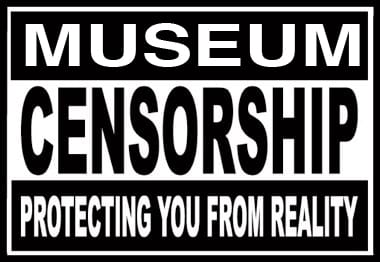Is America Ready to Confront Its Artistic Taboos?
Now that the dust has somewhat settled on the Wojnarowicz and Blu censorship cases, a number of people have been chiming in about what this tells us about the state of art and our culture, specifically American culture. The numerous opinions from where I stand look dire. Here are some fascinating po

Now that the dust has somewhat settled on the Wojnarowicz and Blu censorship cases, a number of people have been chiming in about what this tells us about the state of art and our culture, specifically American culture. The situation looks dire. Here are some worthwhile posts we haven’t mentioned before.
Marc Schiller of Wooster Collective, finally expressed his much anticipated opinion on the Blu mural whitewash, and he focused on the state of the contemporary museum:
For us, it has more to do with the fact that as time goes on, more and more of our museums fail to live up to the ideals that we have for them. We want, and expect, museums to defend our free speech. We want, and expect, museums to provide a home for provocative thought. We want, and expect, museums to provoke and inspire debate. What we should not want is for museums to be so constrained and commercial that they add very little to the public debate.
It’s a sad reality that is chilling to read on the screen. Then they touch upon a major concern many people have already been discussing:
But certainly the removal of Blu’s wall doesn’t signal that the show itself will be very daring and provocative.
If the post on Wooster Collective was insightful, though not as forceful as many street art advocates would have liked, a post by Marc Schiller on France24’s The Observers is more provocatively titled and lays to bare a major blindspot in American culture:
Censored US Anti-war Mural Shows Some Art Subjects Are Still Taboo
How true. If the art world thought LGBT issues were not welcome, I suggest they imagine what a Smithsonian exhibition exploring antiwar art would solicit. Closure of the Smithsonian? House hearings? Firebombings?
Sure, the American art world can show or acquire the coded antiwar sentiments of a Martha Rosler or maybe even Picasso’s “Guernica” (it’s not about America after all) but clear populist anti-war sentiment in American art is relegated to the margins, namely alternative spaces, nonprofits, poor neighborhoods, alternative media, and strangely even some commercial galleries (since in America making money trumps all else, no?).
Artist Michelle Vaughan, aka @black_von, recently posted her thoughts as she has been contemplating the “Strange Art Days” as she aptly named them. She reveals how vulnerable these controversies make her feel.
First, on Smithsonian/Wojnarowicz:
It’s like the Smithsonian is sticking their fingers in their ears when artists complain, but pull them out for the GOP or the Catholic League?
On then on MOCA/Blu [emphasis mine]:
At the time, it seemed like the easy choice — calling it a “curatorial decision” after the art was created/presented. Blu was commissioned and then whitewashed by the museum. Deitch dropped him on his face, but claims he’s “championed street artists for years.” Well, until he has to defend them in the face of potential controversy, with his job and professional reputation at risk.
And the more scary reality:
Deitch and Clough failed both artists miserably; this sets a nasty example and will be repeated if we let them off the hook.
If you aren’t scared yet, you should be, because the advocates for free artistic speech are losing. Big time.
And finally, the Just Seeds blog published a post by Nicholas Lampert this past Monday, which examines what the MOCA/Blu censorship case means beyond the art world:
Deitch’s decision, however, runs deeper than a museum director censoring an artist: it censors debate on the impact of war at home and abroad, and suggests that street artists who are still begging to take Blu’s place in Deitch’s soon-to-be blockbuster show Art in the Streets have lost much of their subversive edge when they play by the museums rules.
He also offers another reading of the mural we’ve never explored in our past posts:
… one could even read the coffins as a metaphor for the commercialization of street art – a once subversive genre covered in money and showcased in elite cultural institutions.
While I have less disdain for the mixing of the commercial art world and the world of street art that Lampert seems to, his reading of the situation is striking for its emphasis on war veterans and dispelling the myths we have about them. He also offers some critical interpretations of some of the street art personalities who have come to the defense of Detich, including Shepard Fairey and Henry Chalfant, both of whom have expressed a convoluted logic about the situation. He also quotes the Schiller statement on Wooster Collective and dissects that. But what I found interesting about his post was his dismay at the disparity in the street art world:
One simply has to look at the Banksy phenomenon. Bansky’s work fetches prices of a half million dollars in auction houses and when he (or one his team of assistants) illegally spray paints a stencil on a city wall, the action is celebrated and valued as art. Conversely, when a teenager from Chicago does the same type of work, he or she can expect a felony and public scorn.
Perhaps I’m less surprised by these extremes since they don’t appear restricted to street art but are part of society all around us. Major military contractors get away with crimes that small business never could, and Wall Street receives massive amounts of corporate welfare while Americans are shocked when a single parent needs government assistance … nothing new here.
What these controversies are teaching me is that we should strive to always see the interconnectedness of each incident with larger issues in society and stop trying to discuss them in isolation, since they are often symptomatic of larger trends and problems.
Another lesson that is becoming apparent is that we cannot expect the corporate art world (galleries, museums, foundations … ) to shatter taboos, they simply package, examine, and probe the accepted.
Btw, if you missed it, I’d suggest you also read Ted Kerr’s “Towards Transparency and Justice, Learning from Wikileaks and Wojnarowicz,” which was published last week on Hyperallergic.





